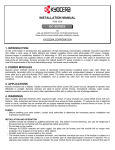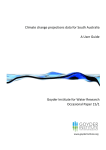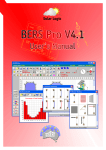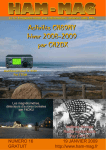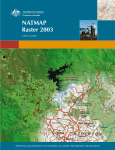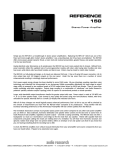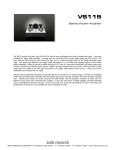Download Operating Instructions for the online tool “rainwater harvesting and
Transcript
Operating Instructions for the online tool “rainwater harvesting and demand simulation” - a.k.a. http://GetTanked.org Accessed from either instance http://rainwater.vpac.org or http://rainwater.vulabs.net Author Eric Laurentius Peterson ¹ ² * ¹ Adjunct Professor, Institute for Sustainability and Innovation, Victoria University, Melbourne, Australia ² Adjunct Senior Fellow, School of Civil Engineering, University of Queensland, St Lucia, Australia Contact email [email protected] These instructions are in support of the manuscript “Transcontinental assessment of secure rainwater harvesting systems across Australia”, Submitted to Resources, Conservation & Recycling 29th December 2014, returned 20th March with comments, resubmitted 20th April 2015. The author hereby documents recommended use of the online tool “rainwater harvesting and demand simulation” linked to from the website URL http://gettanked.org/, which serves only the Australian continent and Tasmania. This tool dynamically calculates the irrigation and evaporative cooling demands in addition to any particular per diem allocation of potable water. The analysis may be either from a finite storage tank of specified capacity, or drawn from water mains. The nominal daily potable water demand of 144 litres per person per diem needs to be critically questioned by any user, and as a result of experience of the Millennium Drought it may be workable to reduce demand to 100 litres per person per diem, cover swimming pools, implement recycling of grey water to supplement irrigation, and to provide shade cloth cover over gardens during heat waves. In surviving drought it is reasonable to maintain the amenity of shade trees and a small garden as well as providing evaporative cooling indoors. If demand can be rationed and appropriately recycled, then secure rainwater harvesting system may be designed to serve in many parts of the Australian continent if sufficient catchment and capacity are provided, or if occasional tanker deliveries are readily available. Tables, sorted by climate classification are found in Appendices A through H of these instructions to tabulate demand restrictions that have been found to avoid running dry within the constraints of a nominal 10 m³ capacity storage with 100 m² catchment– defining the sustainable load per diem (SLPD) during a “worst case” epoch – this is the break-point for absolute security as far as meteorological records can determine since European settlement. SLPD varies from 86 to 124 L/d among most temperate maritime climate stations, and between 35 and 42 L/d at most desert climate stations. Appendix Tables A through H also summarize demand for evaporative cooling and irrigation together with the sustainable yield of a rainwater harvest system at 128 locations throughout Australia. Indoor and potable water demand should be disaggregated from irrigation, pool evaporation, and evaporative cooling to make use of this tool. Material and methods FAO56 irrigation demand (Allen, et al. 1998), and pan evaporation reference the patched point dataset (PPD) data bank, commencing in 1890 for rainfall and 1957 for climate variables (Jeffery, et al. 2001). Daily minimum and maximum temperature and vapour pressure provided by the PPD, together with atmospheric pressure estimated from altitude are used to model the part-load performance of evaporative coolers if the fullload cooling demand is specified. Daily cooling load is scaled on basis of cooling degree days to the base 24°C as described by Peterson (2014) with design drybulb at the locality calculated for the specified epoch by the method of Peterson, et al. (2006). Backend computations and graphics are provided by GNU Octave following an M-file script that is customized in response to the details entered into data forms on the GetTanked website frontend. The website frontend is comprised of javascripts that were compiled with Google Web Toolkit. In order to speed up simulations of multiple combinations of rainwater harvesting system parameters it was decided that the GetTanked tool must first-pass establish a “worst case” quadrennium (4 year epoch).at the case study of interest. The nomination of “worst case” is determined by searching for the two-consecutive years with respect to the difference between rainfall and Australian synthetic Class A pan evaporation. GetTanked includes the formative year as well as the succeeding year to nominate a moderated “worst case” epoch. References Allen RG, Pereira LS, Raes D, Smith M. 1998. Crop evapotranspiration—guidelines for computing crop water requirements: FAO irrigation and drainage paper 56. Rome: FAO–Food and Agriculture Organization of the United Nations. http://www.fao.org/docrep/X0490E/X0490E00.htm Jeffrey, S. J., Carter, J. O., Moodie, K. B., & Beswick, A. R. (2001). Using spatial interpolation to construct a comprehensive archive of Australian climate data. Environmental Modelling & Software, 16(4), 309-330. Peterson, E., Williams, N., Gilbert, D., & Bremhorst, K. (2006). New air conditioning design temperatures for Queensland, Australia. AIRAH Equilibrium February 2006. http://mail.airah.org.au/downloads/2006-02-01.pdf Peterson, E (2014). Mitigation of the energy-water collision through integrated rooftop solar and water harvesting and use for cooling: A critical review. In: What conditions must models and methods fulfill on an urban scale to promote sustainability in buildings? Proceedings of the World Sustainable Building Conference 2014, Barcelona. ISBN 978-84-697-1815-5 http://uq.id.au/e.peterson/GetTanked/Peterson_ref110_Paper89.pdf Graphical Abstract of Rain Water Harvesting and Demand Simulation (Peterson 2015) Precipitation, R Bulk make-up, Mt Area of roof catchment, A in-flow, I Evaporative Cooling, kW overflow, O full volume Vf present storage Vt Potable demand, Dp Irrigation demand, Dg Yield, Y Area of Irrigation, Ag Evaporation, De Total demand, Dt Mains make-up, Mm Area of water , Ae Graphical Abstract: Rainwater harvesting and demand system (RWHS) modelled by the GetTanked tool from the paper “Transcontinental assessment of secure rainwater harvesting systems across Australia”, Submitted to Resources, Conservation & Recycling 20th April 2015. The parameters operating behind GetTanked are illustrated in the Graphical Abstract submitted to the journal Resources, Conservation & Recycling. Besides geographical location, adjustable variables include the potable water demand, Dp, evaporative cooler capacity, kW, the area of garden irrigation demand, Ag, the area of water feature evaporation, Ae, utilized stormwater catchment area, A and the storage capacity of the tank, volume Vf when full, measured above the minimum allowed reserve. The geographical location determines the rainfall supply onto the roof catchment while solar radiation, temperature and humidity determine the FAO 65 evapotranspiration potential (irrigation demand), pan evaporation, and evaporative cooler water consumption. The level of water, Vt, in the storage tank will generally vary at each timestep (daily) t. As rainfall data is most generally available on a daily basis, GetTanked is designed to investigate the reliability of supply from rainwater with deficit periodically avoided by bulk delivery Mt, or by continuous mains make-up Mm. Simulations employ an algorithm where the present storage in the tank Vt is taken as the previous day’s storage in the tank Vt-1 minus the total daily demand, but not allowed to be negative, nor to exceed the maximum capacity of the tank. As yield is not explicitly calculated to determine occasional tank overflows, this model uses yieldsbefore-spill (YBS). GetTanked operates with an in-built assumption of 10 litres first flush diversion each day that rainwater harvesting occurs. The behaviour of supplemental water imports depends if there is a continuous connection to mains for makeup on demand Mm, or if bulk shipments are hauled in to fill the tank whenever it runs dry. GetTanked users can toggle the “water consumption” data entry form to evaluate the continuous-mains make-up, or estimate tanker-trucking orders for premises that are off-grid. Bulk tanker deliveries are the method of makeup employed example output Figures 1 – 5, but mains connected refilling without storage capacity or catchment informs the seasonal demand profiles of irrigation and evaporative cooling. Bulk tanker make-up is normal practice in situations of rural and peri-urban development, where home owners need to ensure that they hold water reserves for fire fighting. There is very little spillage before use as such tanker deliveries tend to be conducted during periods of drought, and so the YBS model is a reasonable method for the purposes of the present study. In either case, yield from the RWHS (Yt) can be calculated as the minimum of total daily demand (Dt); or the sum of daily in-flow (I) and the previous day’s storage (Vt-1). GetTanked utilizes Google Maps interface for users to specify location and the trace the catchment areas A that contribute to the RWHS. The nominated storage tank capacity Vf should be considered by the user by reference to manufacturer’s specification to neglect sludge collection at the bottom and freeboard in the headspace. For example, a 2.2 m internal diameter tank would need to exceed 2.63 m height to achieve 10 kL capacity Vf, and higher to ensure this represents the active-capacity above any required low-level reserve. The GetTanked Google Maps interface also allows users to trace the area of evapotranspiration Ag and evaporation demand Ae, or explicitly specify these areas. GetTanked users may vary the portion of the rooftop rainfall (R × A) entering the inflow of the tank by adjusting the impermeability of the catchment (nominally 0.95). Similarly the user may vary the FAO56 irrigation demand (FAO56 – R) × Ag by specifying a screening factor (nominally 0.0). Finally the user may vary water feature (i.e. swimming pool or open-air reservoir) evaporation by specifying a cover factor (nominally 0.0). Rainwater harvesting and demand simulation data forms The rainwater harvesting and demand simulation tool URL http://GetTanked.org has been forwarding to a server at premises of the Victorian Partnership for Advanced Computing (VPAC), 110 Victoria Street, Melbourne, Australia, but may be redirected elsewhere. In any instance the website, “Rain Water Harvesting and Demand Simulation”, presents a series of data forms for users to specify rainwater catchment, water usage and tank storage capacity to simulate the reliability of supply from rainwater, and to identify supplements that may be required. GetTanked estimates the 'failure rate', being the percentage of imports either made-up from water mains or by tanker truck deliveries. The left hand pane of GetTanked has a green arrow that notes the user’s progress working through seven data-entry forms between Welcome and Submit, with “< Prev” and “Next >” to forward and back as much as desired until selecting ‘Submit’ on the last form, with a wait of up to two minutes for results. Users can revise successive simulations with the “< Prev” and “Next >” toggles, and then submit again before copying resulting graphics (Figures 1 through 5) for pasting into a report. 1. Location is the first data entry form (after the Welcome notice). Select location by either typing in an address or clicking in the Google Maps window. This is the only input for which there is no default, and so we illustrate VPAC’s street address “110 Victoria Street, Melbourne” or geographical coordinates “-37.8066 , 144.9635”. Beware GetTanked runs for any point on earth, using the nearest Australian dataset. 2. Analysis Period is the second data entry form. “Worst Case” or “Manual” specification will be confirmed in Figure 1 in red against the background 121 years of PPD. In the current study the default “Worst Case” option is always accepted, simply advancing “Next >”. 3. Water consumption specifies either “Total Consumption” or “Consumption based on household population”. The latter is the default, with 2 persons dwelling in the home, with 155 L “Daily water consumption per person”. This default is equivalent to entering 310 L/day “Total daily consumption” under the alternative tab. Enter 0 if rainwater harvesting system does NOT serve POTABLE needs, and advance to further data forms to detail modelling of demand for irrigation, evaporative-cooling, and evaporation from swimming pools and water features. Accept default of 155 L per capita per diem, advancing “Next >”. 4. Rain water collection and storage is the fourth data entry form. Users may specify if mains water is available, but the default setting (“No”) assumes that a water tanker is despatched to fill the tank if it runs dry. Demand without reference to supply will be profiled if mains water is declared to be available while also zeroing both tank size and roof size. This form allows adjustment of nominal default 10,000 L capacity, nominal 100 m² catchment and the rather optimistic suggestion of 95% run-off coefficient (1-permeabilitycatchment). Note that “capacity” is intended to represent only the active-capacity of a covered storage reservoir, excluding any required reserve. Google imagery is provided to measure catchment area by tracing polygons over any number of discernible impervious surfaces judged to be useful. 5. Outdoor water use is covered by two data- entry forms, each provided with a Google imagery view of the locality of interest so that the user can trace polygons over the areas of garden irrigation and water body evaporation that demand water from the rainwater harvesting tank. Manual data entry of the square meters of irrigated garden and pool area are also provided, with default at zero. If an area is entered and traced then the default portion covered is zero, which can be adjusted as high as 1 to indicate the area could somehow be absolutely protected from evaporation or evapotranspiration. Zero cover is assumed throughout the present example. In the present discussion accept all defaults, with zero area of both garden irrigation and pool evaporation, and also without evaporative cooling. Thereby only a constant demand for potable water is simulated. Evaporative cooling has been included on the “outdoor water use” form because the process depends on forced convection of outdoor air through the building to displace heat with air approaching the wetbulb temperature of the outdoor air conditions. The evaporative cooling model integrated into GetTanked was described by Peterson (2014), and depends on the user declaring the total cooling capacity of installed evaporative coolers. Direct evaporative cooling does not work when wetbulb temperatures are above the desired indoor temperature of 24°C, and therefor at such times vapour-compression air-conditioning systems could be desired. GetTanked models the consumption of water effectively evaporated, and so splits the demand peaks of spring and autumn – indicating evaporative cooling is often ineffective during summer in such locations. 6. Outdoor water use continued The second outdoor water use form is concerned with evaporation from uncovered water features such as swimming pools or any storage reservoir exposed to pan-like evaporation losses. For the initial illustration of methodology without nonpotable demands accept all defaults on both “Outdoor Water Use” forms, simply stepping forwards “Next >” and then “Next >” 7. User contact details Ambit users may directly click the final “Next >” to skip past the 7th form unless willing to collaborate with the author in a case study or to offer critique. Use of this form is necessary if the user wishes to request a copy of the M-file script that runs on the server, but it is also best to email the author as a prompt because the user register is rarely used and so routine monitoring has not been justified. The forgoing data-forms are analysed by selecting the ”Submit” button to pass parameters to a computer server with results to be displayed once the simulation has completed. It usually takes just one minute for a four-year analysis (default) if no other users happen to submit a job at the same moment. Analysis with evaporative cooling may take two minutes. Figures 1, 2, 3, 4, 5, and “Summary” appear on completion. Select the desired figure tab and then click within the figure to maximize the display and then click again to review other figures or to review data entry forms from “< Prev”. Users may copy figures using right mouse-key “Save picture as”, or “copy” and then paste into a document together with Summary text. Repeatedly skipping through all forms (“Next>”) without amending anything other than the address ignores the buildings that may be discerned in Google imagery. The default 10,000 L active-volume of the tank is fed by 100 m ² catchment with 95% runoff coefficient (5% permeability) supplying a fixed 310 L daily demand during the particular location’s “worst case” quadrennium (4 years period covering an El Niño event). Scripting GetTanked Rain Water Harvesting and Demand Simulation While all of the results presented in these operating instructions were obtained via the GetTanked website interface, interested researchers and professionals could run simulations offline if they install MatLAB or Octave and obtain PPD data from Queensland Science Delivery Division of the Department of Science, Information Technology, Innovation and the Arts (DSITIA) https://www.longpaddock.qld.gov.au/silo/ppd/format.php specified to be in the “Standard including FAO56 Reference Evapotranspiration (ETo)” format and copy into a data folder with the station identification number appended by “.txt” suffix. Each run of the on-line GetTanked tool is custom written in the GNU Octave M-file script that can be obtained by completing the user contact details before submitting a simulation to the GetTanked server http://rainwater.vpac.org. It is then recommended to email the author because user comments are rarely completed, and so the feedback register is seldom monitored. The author can reply with the user’s simulation script, but it must be renamed something short ending with the M-file suffix “.m” and amended wherein the UNIXpath2SILO and/or DOSpath2SILO variables match the local users’ “data” repository of PPD files and an ASCII file named “station_ID_altitude.csv” containing four columns of comma separated station identifier (sorted by ascending BoM number), latitude (°), longitude (°), elevation (m) for each station of the “data” subfolder: station1, latitude1, longitude1, elevation1 station2, latitude2, longitude2, elevation2 … stationn, latituden, longituden, elevationn In the example simulation at the premises of VPAC the station_ID_altitude.csv should contain at least one line “86071,-37.8075,144.97,31.2” while the folder “data” must contain a PPD file named “86071.txt” if not all of the 4759 stations that can be subscribed to. Furthermore the header of PPD files are six lines longer than those that were integrated into the on-line GetTanked tool and so the M-file script must be amended such that lines defining “unix_command1” and “dos_command1” should be replaced as follows: unix_command1=['sed ''1,54d'' ',filename,' > ',filelessheader]; dos_command1=['more +54 ',filename,' > ',filelessheader]; Default output for example address in Melbourne: 110 Victoria Street, Melbourne, Australia Figure 1: Default output from website GetTanked.org “Figure 1” for Melbourne. The difference between evaporation and rainfall over 121 years. Default output for the example address “110 Victoria Street, Melbourne”, Figure 1, illustrates that the “worst case” quadrennium was taken at the end of the available time series, immediately before the return of La Niña wet seasons 2010 and 2011. The vertical axis is the difference between Australian synthetic Class A pan evaporation and rainfall. Figure 2: Default output from website GetTanked.org “Figure 2” for Melbourne. Average monthly water make-up requirement during simulation epoch. Default output Figure 2 presents the seasonal pattern of imports into a 10,000 L tank over the epoch 2006 through 2009, and confirms that simulations are based on Bureau of Meteorology station 86071, lying about one km east of the location of interest. During the 4 years of simulation the average monthly demand for trucking imports is presented. Note that the months of February, April, and October averaged a delivery of one 10 kL shipment of water. It appears that no shipments were required in March or April of the epoch, and that deliveries were not required all of four instances of the other months during the epoch. Beware this plot averaged monthly demand over the four year epoch. Figure 3: Default output from website GetTanked.org “Figure 3” for Melbourne. Import requirement varies with tank capacity and catchment area. Default output Figure 3 presents 56 (8 × 7) variations of tank capacity and catchment area surrounding the nominal 10,000 L tank and 100 m² roof catchment, with the statement that 64% of demand during the epoch (2006-2009) would have required tanker deliveries. The contour of 1% shortfall makes it clear that a quadrupling of both tank capacity and roof catchment would reduce demand for imports near zero. Due to the logarithmic character of this graphic, there is no point in combinations of capacity and catchment far beyond the contour of 1% shortfall. The contour of 10% shortfall suggests possibly economic solutions if occasional refilling by tanker trucking is feasible. Figure 4: Default output from GetTanked.org “Figure 4” for Melbourne. Timeline of tank capacity and overflows for nominal capacity and catchment area Default output Figure 4 provides a daily time-series of the tank capacity and overflow events during the epoch (2006-2009). Rainwater overflow events indicate that more tank capacity would be useful to avoid later demand for refilling. Tanker truck deliveries are implied when the capacity curve runs vertically from near zero, up to near the nominated capacity level (10,000 L) without the coincidence of overflow. There are 29 tanker filling events observed on this plot that can be confirmed by reference to the average monthly demand for imports presented in Figure 2. Figure 5: Default output from website GetTanked.org “Figure 5” for Melbourne. Import requirement varies with recycling of grey water to supplement outdoor irrigation. Without specification of irrigated area the only advice of this figure is to manage the daily demand for potable water indoors. Default output Figure 5 is similar to Figure 3 by stating the nominal RWHS would have required tanker truck deliveries to make-up 64% of demand, but in the case of Figure 5 the nominal among 60 combination (10 × 6) variations of demand and increasing rates of recycling greywater after use as indoor potable water to meet irrigation needs outdoors, and by varying the demand for indoor potable water. Truncated text in the upper left corner is intended to label “Grey water irrigation AND potable water conservation” Truncated text in the lower left corner is intended to label “Use less potable water”. Unfortunately the contour labels of 1% shortfall and 10% shortfall are overwritten. Workflow recommendations A number of useful outputs require comparative re-simulation as they are not available first-pass through the rain water harvesting and demand simulation tool that is found from the link at URL GetTanked.org For example Sustainable Litres Per Diem (SLPD*) in the example of default output for Melbourne, Figure 5 resolves that the demand should be managed somewhere above 78 and below 155 litres per day during the “worst case” drought epoch. The particular breakpoint was later found to be 104 L/d at the example address. The breakpoint is here-to-for referred to as SLPD* where the asterisk denotes that 10,000 L storage and 100 m² catchment defaults apply. The Appendix tables present the SLPD* found at 128 locations around Australia, but at any other location the user is offered the following workflows to determine their locally relevant values of key indicators of RWHS performance. a. Sustainable Load Per Diem The sustainable demand per diem was determined by repeatedly stepping back and forth between the water consumption and submit forms, with a delay of one minute per iteration. Each time inspect Figure 5 and note percentage filling required as well as the demand level closest to the curve of 1% shortfall. Iteration steps are manually continued until they confine the breakpoint of absolute reliability, between two steps separated by one litre per diem. The result is the sustainable load per diem (SLPD*) at the location of interest, where the asterisk indicates the default storage capacity of 10,000 litres and catchment area of 100 m². For example SLPD* is found to be 104 L/d at the example address of 110 Victoria Street, Melbourne. In many locations SLPD* is less than 100 L/d, in which case the percentage shortage over the drought epoch (short) is tabulated in Appendices A-H so that tanker supplements can be arranged if demand remains at constant level of 100 L/d. b. Irrigation (Irrig †) Irrigation demand of any particular situation is obtained by stepping back (“<Prev”) three data entry forms to specify irrigated garden area, then back (“<Prev”) another data entry form to toggle YES with regard to mains water supply and to zero both tank size and roof size, and then back (“<Prev”) one more data entry form to zero potable consumption. Finally forwarding (“Next>”) five data entry forms and reactivating the “Submit” button produces a revised set of Figures 1 through 5. Specifying 10 m² irrigation in the otherwise default output for 110 Victoria Street, Melbourne yield revised Summary Results text: “Assuming an irrigated garden and/or lawn area of 10 square meters.” and “Lawn and garden demand was 100%. The total average demand was 29 L/d, with maximum 92 L/d.” Summary Results text also includes the average and maximum daily demand that would be met with a limitless water mains service – without the nominal rainwater harvesting system. Divide irrigation demand by the irrigated area and report as Irrig †, 2.9:9.2 L/d/m² (av:max). c. Greywater irrigation (recycling indoor potable water after first use) It is reasoned that a per diem ration of 100 litres of potable water may be manageable while non potable demands are also supplied as needed. This suggests two persons dwelling under 100 m² adapting lifestyle to severe drought restrictions, or one person living more lavishly therein. Having completed irrigation-only demand results, step back (“<Prev”) five forms to toggle “Total Consumption” and specify the total daily consumption at 100 litres per day (per diem). Then step forward (“Next>”) one form to toggle “No” mains connection and restore the nominal RWHS (roof size 100 m² feeding 10,000 L tank size). Finally step forward to reactivate the “Submit” button and wait a minute. In the case of Melbourne the nominal RWHS serving 10 m² of garden, then reliability is ensured if 64% of potable demand is recycled for irrigation – otherwise tanker deliveries are required to make-up 21% of demand during the “worst case” epoch, denoted in the revised output “Figure 5”. d. Evaporative cooling demand per diem per kW capacity (ECDkW) Back step and zero all dataforms, except to specify the house equipped with an evaporative cooler having a nominal capacity of 3.5 kW (1 ton of avoided air-conditioning), and step forward to reactivate the “Submit” button and wait two minutes. In this example GetTanked has simulated a 1 ton (3.5 kW) evaporative cooling system’s performance in Melbourne, where Summary Results report an average 18 L./d demand with peak 166 L/d. Revised “Figure 2” shows the peak occurs in March and a secondary peak in January. In the case of Melbourne the result range 5 to 47 L/d/kW and are listed in the results of this study as the evaporative cooling demand per kW capacity, 5:47 ECDkW L/d/kW (av:max). e. Total demand for potable water, irrigation, and evaporative cooling (TPIE ‡) Total demand including 100 L/d potable as well as irrigating 10 m² and 1 ton evaporative cooling is found to average 147 L/d with a peak of 309 L/d in January. Coincidentally, the peak is near Melbourne Water’s drought management “Target 155” for two persons. In the example of Melbourne, one reliable solution to the problem of ensuring 100 L/d potable supply plus irrigation of 10 m² garden and 1 ton (3.5 kW) evaporative cooling is to increase storage to 14,000 litres and catchment to 141 m², while providing grey water recycling or provide imports as illustrated in revised output “Figure 5”. Acknowledgements GetTanked was made possible by Victoria University of Technology, which joined the Victorian Partnership for Advanced Computing (VPAC), to provide logistical support to develop innovative interactive tools. VPAC provided the GetTanked website to read my program script with open source Octave. Lachlan Hurst developed the Google Maps mashup “front end” alpha version, with final version of the website developed by Daniel Micevski. Resources, Conservation & Recycling peer-reviewers suggested these operating instructions be freely posted on-line. Appendix A: Tropical group, Am and Aw monsoon and savanna climates, typified by Cairns and Bowen pk. mo. pk. mo. climate ECDkW Cooling TPIE ǂ total L/d/kW SLPD* Irrig † Design Pot. +Irrig placename dry epoch short (L/d) (L/d/m²) db/wb +Evap (L/d) av:max COOKTOWN QLD 2002 2005 Aw 14% 87 3.6 :8 10 35.5 /26.6 8 :49 8 163 :309 CAIRNS QLD 2002 2005 Am 14% 71 3.5 :8 10 34.0 /24.9 9 :55 8 168 :329 DARWIN NT 1978 1981 Aw 27% 63 3.8 :7 9 35.4 /25.8 4 :25 7 153 :248 BOWEN QLD 2001 2004 Aw 41% 51 4.0 :7 11 33.8 /26.7 13 :67 8 187 :372 44% 51 3.6 :6 10 33.5 /26.1 5 :23 8 151 :233 GOVE NT 1951 1954 Aw PORT KEATS NT 1991 1994 Aw 41% 47 4.2 :8 10 38.1 /27.4 6 :36 7 163 :273 NORMANTON QLD 1970* 1973* Aw 41% 46 5.0 :9 10 39.1 /23.9 8 :38 7,11 176 :278 GEORGETOWN QL 1969 1972 Aw 41% 46 5.0 :9 10 39.9 /23.5 10 :47 7 185 :309 TOWNSVILLE QLD 1993 1996 Aw 34% 44 4.1 :9 1,10 35.0 /24.0 12 :66 7 184 :369 TINDAL NT 1961 1964 Aw 34% 43 4.7 :8 10 40.1 /26.3 9 :43 6,10 179 :295 * Normanton’s epoch 1970-‘73 caused a failure of evaporative cooling calculations, so years 2006-2009 used for ECDkW and TPIE results. 100m² 10kL 100L/d Appendix B: BSk cold semi-arid (steppe) climate, typified by Mildura pk. mo. pk. mo. climate ECDkW Cooling TPIE ‡ total L/d/kW SLPD* Irrig † Design Pot. +Irrig short (L/d) (L/d/m²) db/wb +Evap (L/d) placename dry epoch av:max KYANCUTTA SA 2006 2009 BSk 34% 65 3.7 :10 1 43.6 /22.4 9 :45 10,12 170 :293 NORSEMAN WA 1971* 1974* BSk 34% 62 3.7 :9 12 40.7 /22.7 9 :53 12,3 169 :318 LAKE GRACE WA 1972 1975 BSk 27% 62 3.4 :9 12 39.3 /21.1 8 :51 3,12 163 :323 SOUTHERN CROSS 1976 1979 BSk 41% 59 4.0 :9 1 40.8 /20.1 8 :50 11,4 168 :310 WAILLTON VIC 1981 1984 BSk 21% 56 2.9 :9 12 40.5 /21.6 7 :52 12,2 155 :327 MILDURA VIC 2006 2009 BSk 55% 51 3.9 :9 1 41.9 /21.3 8 :43 12 166 :293 SWAN HILL VIC 1981 1984 BSk 27% 49 3.5 :9 1 41.3 /21.6 8 :40 12,3 162 :290 RENMARK WA 2002 2005 BSk 48% 45 3.8 :10 1 41.1 /20.7 10 :51 3,12 172 :306 * Norseman’s dry epoch 1971-1974 caused a failure of evaporative cooling calculations, so year 2006-2009 used for ECDkW and TPIE results. 100m² 10kL 100L/d Appendix C: BSh hot semi-arid climate, typified by Charleville pk. mo. pk. mo. climate ECDkW Cooling TPIE ‡ total L/d/kW Design Pot. +Irrig SLPD* Irrig † short (L/d) db/wb +Evap (L/d) placename dry epoch (L/d/m²) av:max TENNANT CREEK N 1985 1988 BSh 48% 76 5.6 :9 11 41.5 /21.4 10 :33 1 193 :287 CUNNAMULLA QLD 2005 2008 BSh 34% 66 4.8 :9 1,10 43.1 /22.2 8 :40 9,4 127 :233 DALWALLINU WA 1976 1979 BSh 27% 63 4.1 :10 1 41.7 /21.3 8 :39 11,4 168 :288 QUILPIE QLD 2005 2008 BSh 34% 60 5.1 :9 1,10 43.2 /25.2 9 :41 5,9,1 183 :286 COBAR NSW 2005 2008 BSh 41% 57 4.4 :9 1 41.9 /20.5 7 :38 10,4 168 :304 EMERALD QLD 2002 2005 BSh 27% 52 4.6 :9 11 40.1 /24.7 10 :50 8,5 182 :313 KUNUNURRA WA 1985 1988 BSh 41% 51 5.4 :9 10 42.5 /27.6 7 :25 7,10 179 :269 WYNDHAM WA 1989* 1992* BSh 34% 51 5.6 :9 10 42.1 /27.4 6 :29 7,10 173 :280 CHARLEVILLE QLD 1991 1994 BSh 41% 50 4.7 :9 1 39.8 /21.4 11 :55 9,5 186 :341 KALGOORLIE WA 1976 1979 BSh 55% 45 4.2 :9 1 41.0 /20.4 8 :45 10,4 169 :295 WINTON QLD 1982 1985 BSh 55% 45 5.3 :9 12 42.6 /23.1 10 :49 8,5,1 189 :311 MOUNT ISA QLD 1985 1988 BSh 48% 44 5.5 :9 1,10 41.2 /22.5 11 :50 8,1 193 :315 BROOME WA 1992 1995 BSh 51% 38 5.1 :9 11,3 38.6 /22.9 9 :43 7 182 :295 CURTIN WA 1971 1974 BSh 41% 37 5.2 :9 10 41.0 /24.2 8 :37 7,11 179 :272 RICHMOND QLD 2002 2005 BSh 48% 36 5.5 :9 10,3 41.7 /23.4 11 :45 7 195 :299 LONGREACH QLD 2002 2005 BSh 55% 32 5.5 :9 12 42.5 /21.9 11 :48 8,5 195 :310 * Wyndham’s epoch 1989-1992 caused a failure of evaporative cooling calculations, so years 2006-2009 used for ECDkW and TPIE results. 100m² 10kL 100L/d short BWh 55% BWh 48% BWh 62% BWh 62% BWh 55% BWh 55% BWh 55% BWh 62% BWh 62% BWk 55% BWh 55% BWh 62% BWh 62% SLPD* (L/d) 47 44 42 42 41 38 37 36 35 35 30 27 26 Irrig † (L/d/m²) 5.3 :10 5.6 :9 4.6 :9 4.1 :10 5.1 :9 5.3 :10 4.8 :9 4.6 :10 5.6 :10 4.1 :9 5.1 :10 5.5 :10 5.9 :10 Cooling Design db/wb 12 42.1 /23.6 12 43.7 /23.9 12 40.9 /20.5 1 41.8 /19.5 12 41.7 /20.1 1 43.0 /22.1 1 43.2 /20.1 1 42.7 /20.3 10,3 43.7 /24.4 1 42.0 /22.2 12 44.7 /22.7 11 43.1 /22.4 12 43.9 /23.1 ECDkW L/d/kW av:max 9 10 7 10 8 10 7 7 10 8 8 9 9 :38 :44 :41 :46 :36 :41 :39 :37 :36 :42 :34 :33 :29 pk. mo. dry epoch 1978 1981 1989 1992 1988 1991 1977 1980 1969 1972 1969 1972 1976 1979 2006 2009 2006 2009 1981 1984 1971 1974 1971 1974 1982 1985 100m² 10kL 100L/d pk. mo. placename LEARMOUTH WA URANDANGI QLD CARNARVON WA FORREST WA MEEKATHARRA W WINDORAH QLD LEONORA WA WOOMERA SA BOULIA QLD BROKEN HILL NSW BIRDSVILLE QLD PORT HEDLAND W ROEBOURNE WA climate Appendix D: Desert group, BWh and BWk hot outback and cold nullarbor climates, typified by Woomera and Broken Hill 9,5,2 8,1 5,10 10,3 1,9,4 5,9,1 4,10 10,4 8,5,1 3,10 9,1,5 7 8,1 TPIE ‡ total Pot. +Irrig +Evap (L/d) 185 :288 191 :295 171 :284 176 :303 179 :285 188 :298 174 :284 170 :299 190 :299 167 :286 179 :297 186 :294 190 :291 Csa Csa Csa Csa Csa short 21% 27% 27% 27% 21% SLPD* (L/d) 76 69 63 60 59 Irrig † (L/d/m²) 3.3 :9 3.6 :9 3.4 :9 4.0 :9 3.4 :9 1 1 1 12 1 Cooling Design db/wb 37.0 /21.8 39.7 /21.3 38.0 /20.1 41.4 /20.9 38.1 /20.8 ECDkW L/d/kW av:max 7 7 7 8 7 :43 :42 :43 :39 :42 pk. mo. dry epoch 1977 1980 1994 1997 1994 1997 1976 1979 1993 1996 100m² 10kL 100L/d pk. mo. placename MANDURA WA PERTH ARPT WA LANCELIN WA GERALDTON WA PERTH CITY WA climate Appendix E: Csa west coast mediterranean climate, typified by Geraldton 4,12 11,3 3,1 11,4 12 TPIE ‡ total Pot. +Irrig +Evap (L/d) 157 :296 162 :295 158 :305 167 :280 158 :293 Csb Csb Csb Csb Csb Csb Csb Csb Csb Csb Csb Csb short 0% 0% 0% 0% 7% 7% 21% 7% 7% 21% 27% 21% SLPD* (L/d) 120 114 110 100 99 95 94 88 87 81 73 63 Irrig † (L/d/m²) 1.6 :7 2.1 :9 2.3 :9 2.9 :9 2.5 :9 3.1 :9 2.6 :8 2.5 :8 2.9 :9 3.0 :9 3.3 :9 2.6 :7 1 1 1 1 1 1 12 12 12 1 1 1 Cooling Design db/wb 27.7 /20.0 37.8 /18.4 33.4 /20.3 38.1 /19.9 38.1 /20.7 37.1 /20.0 27.4 /17.4 32.1 /20.6 38.1 /21.4 37.7 /22.0 39.4 /20.8 28.7 /19.2 ECDkW L/d/kW av:max 3 5 7 6 5 5 3 5 8 9 6 3 :99 :55 :77 :48 :60 :48 :71 :89 :53 :55 :44 :84 pk. mo. dry epoch 1981 1984 1981 1984 1994 1997 2006 2009 1981 1984 1976 1979 2001 2004 1979 1982 1972 1975 1977 1980 2006 2009 2006 2009 100m² 10kL 100L/d pk. mo. placename CURRIE TAS MT GAMBIER SA ALBANY WA MT. LOFTY SA LAVERTON VIC ADELAIDE CITY SA CAPE LEEUWIN WA MORUYA HDS NSW ESPERANCE WA KATANNING WA ADELAIDE ARPT SA NEPTUNE ISL SA climate Appendix F: Csb oceanic mediterranean climate, typified by Adelaide City 2 1 1,4 1 11,2 1 2,4 2,9 12 12 1 1 TPIE ‡ total Pot. +Irrig +Evap (L/d) 125 :483 138 :343 146 :427 150 :322 143 :348 150 :317 135 :395 142 :450 157 :327 161 :341 153 :304 136 :444 Cfa Cfa Cfa Cfa Cfa Cfa Cfa Cfa Cfa Cfa Cfa Cfa Cfa Cfa Cfa Cfa Cfa Cfa Cfa Cfa Cfa Cfa Cfa Cfa Cfa short 0% 0% 0% 0% 0% 0% 0% 0% 0% 7% 7% 7% 7% 7% 14% 14% 7% 7% 21% 7% 7% 14% 27% 21% 27% SLPD* Irrig † (L/d) (L/d/m²) 159 3.0 :8 1 132 2.9 :8 12 129 2.9 :9 12 125 2.7 :8 12 125 2.9 :9 12 117 2.7 :8 12 111 3.2 :8 11 100 3.0 :9 12 100 3.2 :9 1 98 3.3 :9 12 98 2.8 :7 12 96 3.3 :8 1 96 3.1 :8 12 89 2.9 :8 1 86 3.1 :9 1 79 3.6 :9 1 78 3.4 :9 12 78 4.1 :9 1 76 4.3 :9 1 76 3.8 :8 12 69 3.3 :9 12 68 3.1 :8 12 65 4.1 :8 11 64 4.1 :8 11 64 4.2 :9 12 Cooling Design db/wb 30.2 /23.8 33.9 /21.8 37.8 /24.0 34.0 /22.2 35.6 /23.2 32.8 /22.9 34.3 /25.3 37.7 /23.0 39.1 /23.3 35.4 /22.9 31.7 /23.8 38.0 /21.8 33.7 /22.5 32.2 /23.7 38.1 /21.4 40.8 /20.3 39.4 /23.3 39.6 /23.1 39.6 /22.7 37.7 /25.6 37.4 /22.5 36.4 /21.1 35.7 /25.3 35.2 /24.7 38.2 /25.7 ECDkW L/d/kW 7 6 8 5 6 9 16 8 7 13 10 13 13 12 9 8 10 10 11 14 10 10 14 11 12 :63 :53 :56 :67 :53 :75 :89 :56 :52 :69 :85 :68 :77 :90 :67 :54 :60 :55 :57 :63 :70 :66 :59 :48 :51 pk. mo. dry epoch 2000 2003 1979 1982 1979 1982 1979 1982 1979 1982 1979 1982 1979 1982 1979 1982 2006 2009 1993 1996 1996 1999 2002 2005 1993 1996 2001 2004 2006 2009 2006 2009 1979 1982 2002 2005 2001 2004 2005 2008 1979 1982 1979 1982 2001 2004 2001 2004 2001 2004 100m² 10kL 100L/d pk. mo. placename CAPE MORETON QLD SYDNEY CITY NSW WILLIAMTOWN NSW NEWCASTLE NSW SYDNEY ARPT NSW COFFS HARBOUR NSW MARYBOROUGH QLD BANKSTOWN NSW BURRINJUCK NSW ARCHERFIELD QLD GOLD COAST QLD COONABARABRAN NS BRISBANE QLD COOLANGATTA QLD YOUNG NSW WAGGA WAGGA NSW SCONE NSW MOREE NSW ROMA QLD GAYNDAH QLD MUDGEE NSW NULLO MTNS NSW ST LAWRENCE QLD GLADSTONE QLD ROCKHAMPTON QLD climate Appendix G: Cfa humid sub-tropical climate, Typified by Brisbane 11,4 3,9 4,12 9,3 3,9 4,12 9,5 4,10 10,12,3 9,4 4,11 3,11 4,9 11,4 12,3 10,3 4,10 10,4 9,4 5,9 3,10 3,12 8,5 8,5 8 TPIE ‡ total Pot. +Irrig +Evap (L/d) 153 :335 150 :328 156 :334 143 :362 151 :326 159 :409 189 :440 158 :336 158 :323 178 :378 163 :445 180 :386 175 :418 170 :445 164 :371 164 :335 170 :339 177 :323 182 :343 188 :358 169 :389 167 :381 190 :341 178 :306 183 :325 dry epoch 2006 2009 1988 1991 1971 1974 2005 2008 2006 2009 1971 1974 2006 2009 2006 2009 1979 1982 2003 2006 2006 2009 1979 1982 1982 1985 1981 1984 2006 2009 2006 2009 1981 1984 2006 2009 2006 2009 1979 1982 Cfb Cfb Cfb Cfb Cfb Cfb Cfb Cfb Cfb Cfb Cfb Cfb Cfb Cfb Cfb Cfb Cfb Cfb Cfb Cfb 100m² 10kL 100L/d short 0% 0% 0% 0% 0% 0% 0% 0% 0% 0% 0% 0% 0% 0% 0% 0% 0% 0% 0% 0% pk. mo. placename PALMERS LOOKOUT T CAPE BRUNY TAS WONTHAGGI VIC GELLIBRAND VIC WILSONS PROM VIC LATROBE VALLEY VIC CAPE OTWAY VIC MAATSUYKER ISL TAS GABO ISLAND VIC CAPE GRIM TAS WYNYARD TAS KATOOMBA NSW LAUNCESTON TAS WARRNAMBOOL VIC CERBERUS VIC SHEOAKS VIC MORTLAKE VIC HOBART CITY TAS RHYLL VIC MOUNT BOYCE NSW climate (First of two pages) SLPD* Irrig † (L/d) (L/d/m²) 172 1.7 :7 1 161 1.5 :7 1 157 1.9 :8 1 153 2.0 :8 1 146 2.0 :8 1 142 2.1 :8 12 138 2.0 :8 1 138 1.5 :7 2 137 2.0 :6 1 125 1.6 :6 1 123 1.8 :7 1 121 2.3 :8 12 117 2.0 :7 1 117 2.0 :8 1 113 2.2 :9 1 109 3.3 :9 12 109 2.2 :9 2 108 2.2 :8 1 108 2.2 :9 1 106 2.4 :8 12 Cooling Design db/wb 26.4 /17.9 26.4 /16.4 32.5 /21.7 33.6 /18.9 30.9 /20.3 33.6 /21.4 31.4 /18.8 26.0 /14.9 25.7 /20.1 23.0 /17.6 26.4 /17.5 32.2 /18.8 29.8 /18.7 36.5 /21.1 35.8 /21.3 35.8 /20.2 36.0 /20.9 30.5 /17.9 34.5 /21.4 32.0 /18.8 ECDkW L/d/kW av:max 2 2 7 4 3 7 3 :82 :71 :87 :67 :77 :68 :90 pk. mo. Appendix H: Cfb maritime climate, typified by Melbourne 1 1 3 3,12 12,3 3,12 10,3,1 NaN 2 :101 1 1 :67 2 3 :90 1,11 7 :81 12 8 :115 2 4 :65 2,11 5 :63 3 7 :63 1,3 5 :61 2 5 :97 1 5 :59 3 7 :85 12 TPIE ‡ total Pot. +Irrig +Evap (L/d) 124 :436 120 :397 143 :436 134 :380 131 :407 145 :388 131 :459 120 :401 128 :494 111 :153 129 :479 146 :441 148 :555 133 :374 138 :364 148 :368 140 :365 141 :490 138 :347 149 :443 Cfb Cfb Cfb Cfb Cfb Cfb Cfb Cfb Cfb Cfb Cfb Cfb Cfb Cfb Cfb Cfb Cfb Cfb Cfb short 0% 0% 0% 0% 0% 0% 0% 7% 7% 7% 14% 14% 7% 14% 14% 7% 7% 7% 14% SLPD* Irrig † (L/d) (L/d/m²) 104 2.8 :8 12 104 2.5 :8 12 104 2.5 :9 1 104 2.1 :7 12 104 2.9 :9 1 104 2.2 :8 1 100 2.1 :8 1 96 2.0 :6 1 90 2.4 :8 1 87 2.2 :6 1 84 3.1 :9 1 84 2.4 :9 1 83 2.5 :9 1 83 2.5 :8 12 82 2.7 :9 1 82 2.7 :8 12 77 2.7 :8 1 73 2.9 :8 1 73 2.3 :8 1 ECDkW Cooling L/d/kW Design db/wb av:max 35.1 /21.9 7 :55 33.0 /21.4 7 :75 37.3 /21.4 6 :57 25.3 /18.6 2 :80 37.5 /20.9 5 :47 37.1 /19.5 6 :57 30.9 /18.6 6 :109 25.4 /18.0 2 :89 34.6 /21.5 9 :83 30.1 /20.0 13 :113 39.6 /22.0 8 :59 37.1 /20.6 5 :62 37.0 /20.3 7 :67 33.4 /19.7 9 :86 36.6 /22.4 12 :78 35.4 /21.1 9 :73 36.0 /21.7 9 :71 36.1 /20.9 10 :72 30.7 /18.5 5 :110 pk. mo. dry epoch 1979 1982 1979 1982 2006 2009 1997 2000 2006 2009 1981 1984 1967 1970 2006 2009 2005 2008 1903 1906 2006 2009 2006 2009 1981 1984 1979 1982 1979 1982 1979 1982 1981 1984 1979 1982 2006 2009 100m² 10kL 100L/d pk. mo. placename NOWRA NSW ULLADULLA NSW MOORABBIN VIC EDDYSTONE PT TAS MELBOURNE VIC HAMILTON VIC MT. WELLINGTON Ts DEVONPORT TAS EAST SALE VIC BOMBALA NSW MANGALORE VIC GEELONG VIC ARARAT VIC BRAIDWOOD NSW BEGA NSW GOULBURN VIC BATHURST NSW CANBERRA ACT HOBART ARPT TAS climate Appendix H continued: Page two of two maritime climate 12,3 12,3 1,3 2,12 3,1 2,12 1 2 1 1 12,3 3,11 12,2 12,2 3,12 12 12 12 12,3 TPIE ‡ total Pot. +Irrig +Evap (L/d) 153 :335 150 :403 146 :344 126 :422 147 :309 145 :336 142 :534 127 :469 154 :428 168 :531 159 :349 142 :358 149 :376 158 :456 170 :411 159 :396 160 :397 164 :390 142 :535























